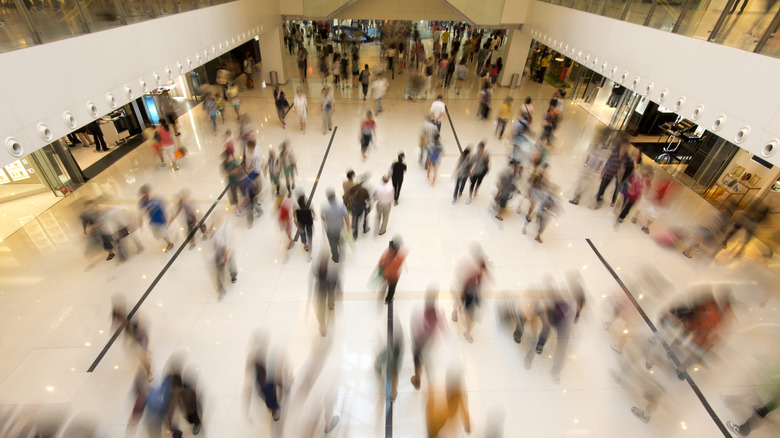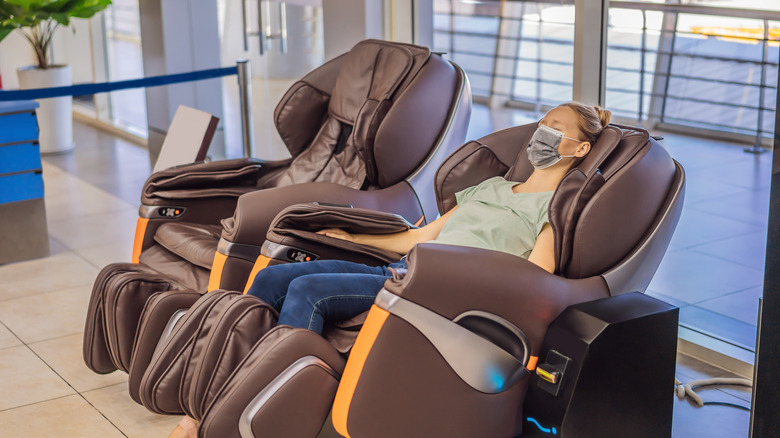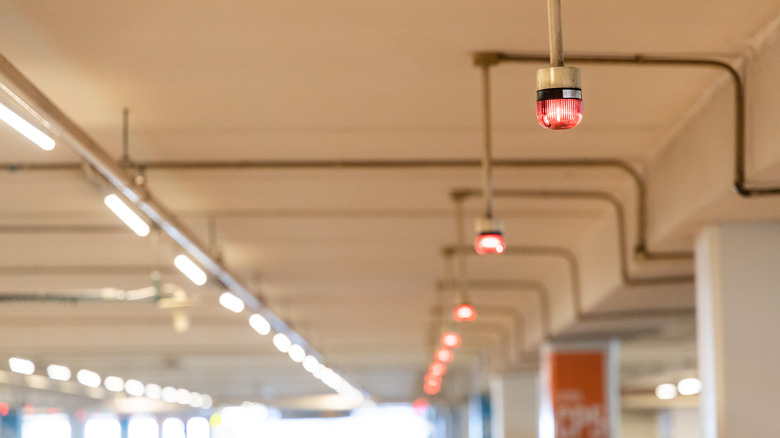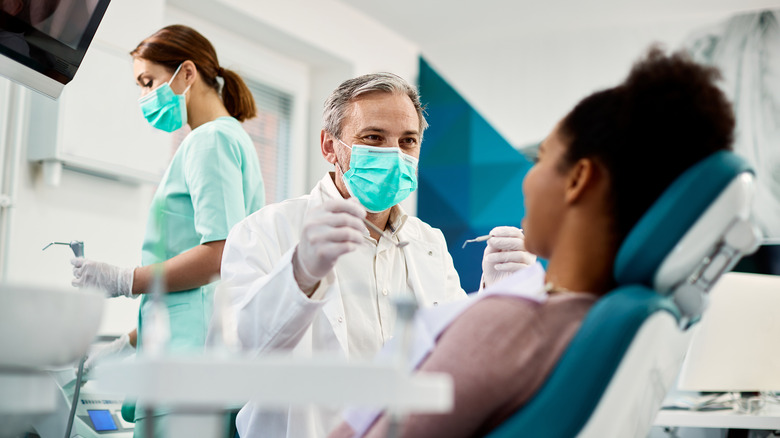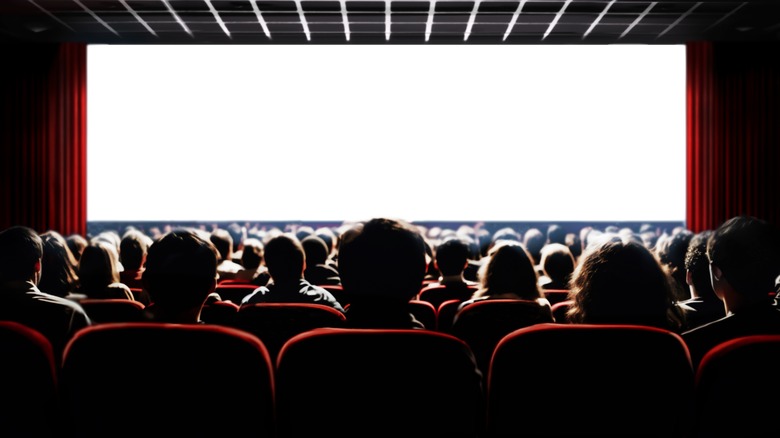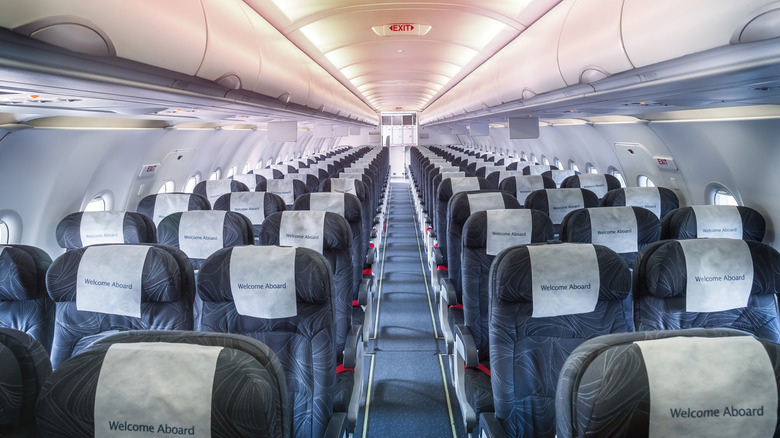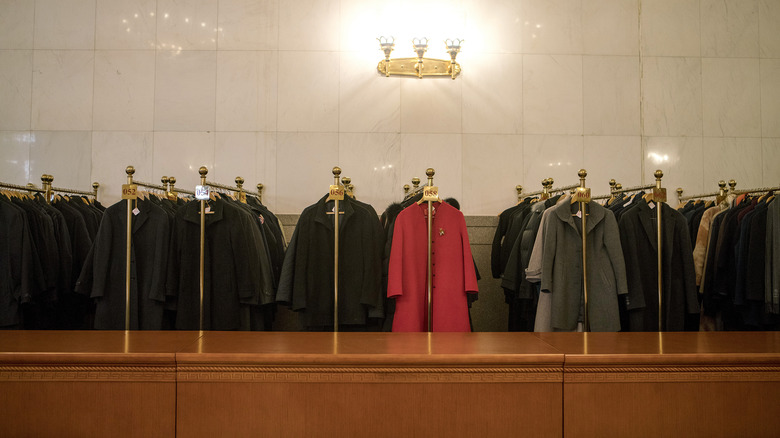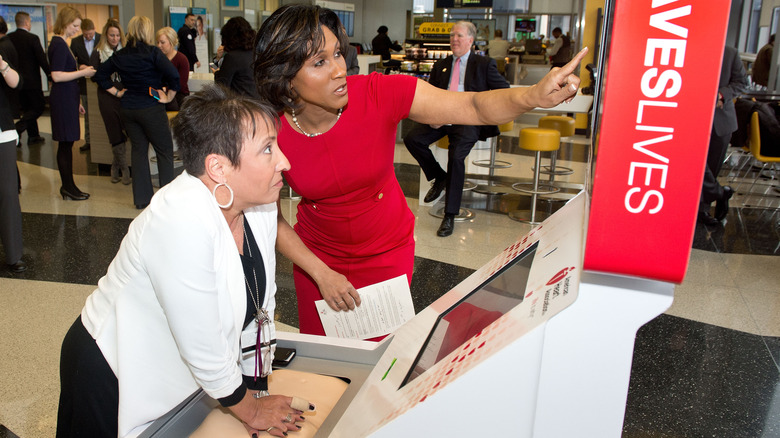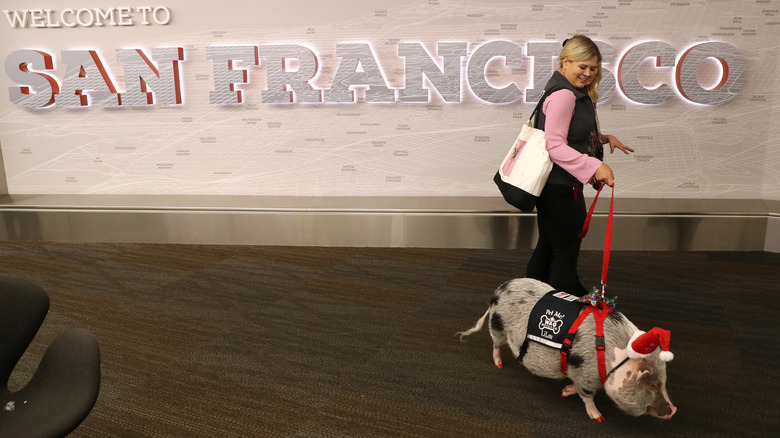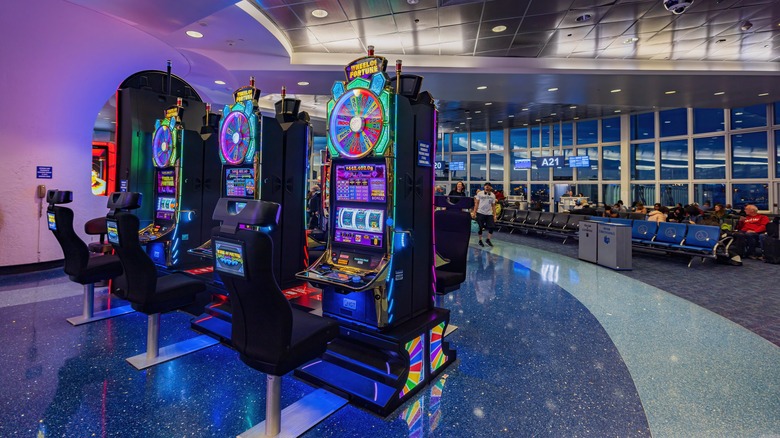13 Underrated Amenities You Can Find At Different US Airports
Folks, let's not beat around the bush: air travel stopped being fun a while ago. If it's not the fact that every airport seems like the busiest airport in the world, then it's the absurd ticket prices, constant delays, long lines, invasiveness of the TSA, and waves of human cattle who seem to have learned their public etiquette from rugby games. And that's not to speak a word of the shenanigans that come into play onboard the aircraft itself. We only bite the bullet because an incredible destination awaits us on the other side, one worth being crammed into economy class like clothes in a space bag for.
Credit where credit is due, airports have done a commendable amount to mitigate the headache they contribute to the voyage. In particular, they've made some of the amenities available in their terminals a worthwhile way to pass the time while waiting for a flight. Rest assured, we're not here to discuss the humdrum of duty-free shopping nor paying an arm and a leg for a lackluster meal. Today's list covers worthwhile, underrated amenities that you, dear traveler, can avail of in (some) U.S. airports right now.
Spa services
At first glance, spas and airports may seem as opposite as heaven and hell. Getting a spa treatment at the airport sounds like getting a mani-pedi at the DMV. Perhaps you've seen one and walked right on by, wondering how you could ever ease into a spa mindset knowing you have to fight for a carry-on luggage spot later. On the contrary, the best time to head to the spa is when your cortisol levels are high, something a spa can help reduce. Loosening your muscles and easing joint pain will make the cramped conditions of an airplane seat much more bearable, and mental relaxation will make cabin pressure and crying babies more tolerable.
You'd be surprised how many airport spa locations there are across the U.S. XpresSpa, one of the largest brands, has locations in 11 US cities, with dozens more abroad. Several are open as early as 6 a.m. and as late as 11 p.m. They provide a whole gamut of services, from massages to zero-gravity loungers. They claim there's something for everyone, whether you've got five minutes or a full hour. We advise making an appointment in advance; you're unlikely to find open spots unless you happen to be there off-peak. Check out competing brands like Terminal Getaway Spas and the much older Massage Bar. Some only exist in a single airport, such as Enroute Spa in Indianapolis International (IND), and some exist only in airport hotels, like skySPA in Dallas-Fort Worth's Hyatt.
Parking vacancy indicator lights
It seems like every step of taking a flight is bent on being as infuriating as possible, and the drive into the airport is no different. Unless you've got a friend to drop you off, you've got to deal with crowded airport parking, which is another travel cost on top unless you know the best ways to save on airport parking. Most airports have your run-of-the-mill parking garages, and in almost all cases, they suffer from the same fatal flaw — you have no idea where open slots are or how many are left. It's a shame, since parking vacancy indicator lights are an easy solution to this problem that is common elsewhere in the world.
It's a simple idea. Lights positioned above each parking slot shine green for available spots or red for taken ones. Baltimore/Washington International Airport (BWI) has this Smart Park tech in their hourly and daily garage. You can find out at the entrance how many spots are left in real-time, a huge timesaver that spares you prowling a half-dozen levels in vain. San Antonio International (SAT), Fort Lauderdale-Hollywood International (FLL), and Austin-Bergstrom International (AUS) have likewise deployed their own implementations of this tech. With luck, more major U.S. airports will get on the bandwagon. Arriving early to check in and get through security is essential, and this little amenity helps to shave off a few vital minutes.
Dental services
Airports and dentists go hand in hand concerning painful experiences you must endure to get to the better parts of life. Combining them would seem like a crime. You might change your tune, however, if you get a toothache the night before your flight, one that worsens the next morning and threatens to upend your trip. Dental emergencies are no joke, but your local practitioner might be out of the way, and you're probably not keen on getting an infected tooth removed in a foreign language. Those tickets probably aren't refundable, after all. Enter airport dental services.
Dr. Trager at JFK runs one among a surprisingly large list of airport-specific dental practices. Aside from the occasional emergency, his services include your typical cleaning and teeth whitening. For some, going to the dentist at the airport is a more effective use of your time. Why kill an hour looking at ludicrously overpriced Bulgari watches when you can get your regular half-year appointment knocked off the calendar? Plus, you might want your pearly whites looking their best before you update your social media pictures abroad. Whatever your reasons, you'll be glad there was a dentist there in the first place.
Cell phone lots
Cell phone lots are something of an open secret at airports, one even some of the most seasoned travelers may not be aware of. In essence, they are car parks just outside the main terminals where you can wait — parked in your car — until the flight arrives for the person you're picking up. The name originates from the idea that you're waiting for "the call" from your incoming traveler, but these days, it gives us the impression of bored people in their cars scrolling through their phones. It not only helps reduce airport congestion (otherwise, you'd be doing laps around the arrival area) but provides a more tranquil place to wait compared to a bustling terminal. Best of all, they're usually free, and dozens of U.S. airports have them.
We want to home in on one stellar example. Denver International's (DEN) 24/7 free cell phone lot is a cut above the rest. There's a lounge with free WiFi, restrooms, and a children's seating area. Have a quick bite at Dunkin, Schlotzsky's, and a handful of other restaurants while you're there, operating hours permitting. A convenient Phillips 66 gas station sits across the way for fuel-ups. As far as cell phone lots go, this one is so good you might even come a bit earlier than usual just to enjoy it.
Microcinema
If you've got an international flight, many major airlines will advise arriving at least two to three hours before your departure. If you have heeded that wisdom (as you should; you never know what could happen), you may have found yourself at the airport an hour or more ahead of schedule without anything meaningful to pass the time — enough time to watch a feature-length film, in some cases. Portland's Hollywood Theatre saw a prime opportunity here for travelers to get a culturally enriching experience and ran with it.
Portland International (PDX) hosts the Hollywood Theatre, located after security in the C Concourse area. Entrance is free, but do keep in mind that these won't be typical blockbusters. All the films they show are no longer than 10 minutes and are made by local Pacific Northwest cinematographers. Anticipate artsy, low-budget (but passionate) indie films appropriate for all ages. We can't speak to the quality of the films in question, but we'd argue it's a much better 10 minutes than Candy Crush. Thanks to the brief durations of the films, you won't risk missing the boarding call and won't be too miffed if the ending fails to pay off.
A mock aircraft cabin
Aerophobia, the fear of flying, affects a whopping 40% of people in the U.S. For some, it's a mild anxiety that can be treated by looking out the window during take-off or doing this game-changing meditation technique. For others, it's a debilitating phobia that robs you of the beauty of traveling. Depending on where you fall on that spectrum, one airport may have something approximating a cure. Minneapolis-St. Paul International (MSP) features a Delta Airlines cabin simulator, an authentic cut-out section of a retired airplane located in Concourse C.
The inside is bang-on with what you'd expect in an actual airplane, with real seats, functioning seatbelts, and overhead carry-on storage compartments. According to MSP via MPR News, the primary goal is to help those with physical and developmental disabilities experience a real flight, minus getting off the ground. Those who wish to conquer the fear of flying are welcome, as is anyone else curious enough to take part. It is a core part of the Navigating MSP program and occasionally doubles as a foley for security and EMS training. Note this isn't something you can take a peek at on a whim. You will need to pre-register and schedule with a group, but it is 100% free of charge.
Coat check service
Bringing a coat on your travels sucks, let's be real here. You've usually got two options: Wear it on the plane, or, if you'd rather have some semblance of comfort in the cabin, sacrifice half the space in your carry-on to stow it. This problem gets compounded if you're traveling from a cold destination to a warmer one, such as, say, from chilly Maine to the sweltering Bahamas. You'll need that coat coming home, so you're forced to drag it along with you. If you happen to be traveling out of Milwaukee, as one example, then you can check it in instead.
Milwaukee Mitchell International's (MKE) coat check is available from November 1 until April 1 of the following year and is open seven days a week. They let you check in everything, including coats, gloves, scarves, and any winter items you choose to leave behind. It only costs $2 and maxes out at $10 if you're on an extended trip. It doesn't matter which flight you're on, but international travelers should keep in mind they'll need to navigate to the Main Terminal for pickup. MKE isn't the only one to provide this service, either. JFK also does, as do several international cold-weather destinations like Frankfurt (FRA) and Incheon (ICN), should you be traveling abroad.
Meditation rooms
From honking cars at the arrival pickup queue to chattering serpentine lines at security, airports are inimical to the pensive and meditative among us. Airport chapels, mosques, and synagogues do offer some reflective sanctuary prior to a flight, and they're great places if you have a particular religious affiliation, but perhaps not so much if you're just passing through. For those who prefer a non-denominational location, you can head to a meditation or yoga room. Locations span the entire country. There's one in San Francisco (SFO), Dallas-Fort Worth (DFW), and Raleigh-Durham (RDU), among others.
They may take a long walk to reach (they tend to be off the beaten path), but the effort will be worth it. These are dedicated quiet rooms with yoga mats, walking paths, and, in some cases, soothing music to go along with it. Some are open 24/7, and all of them are free. A few, like Chicago's O'Hare International (ORD), loop video yoga tutorials to help you stretch ahead of your flight.
CPR training kiosks
CPR is one of those things that you probably have a general understanding of but might shy away from putting into practice if called upon to assist someone who is unresponsive. Still, this is a procedure everyone should know, one that could save a life and one that requires very little training. Heart attacks and other emergencies while in the air are rare; that much is true, but they do happen. Take this recent incident on an El Al flight, as reported by Y Net. Long story short, it never hurts to be prepared. A CPR kiosk provides a free, easy, and convenient way to get that training when you probably won't be doing anything important or pressing.
These Hands-On CPR training kiosks can be found across the country, at major airports like Los Angeles (LAX) and Orlando (MCO), as well as smaller ones like John Wayne (SNA) and Cincinnati/Northern Kentucky (CVG). There's proof that they've saved lives, too. A YouTube video shows how a guy named Matt learned CPR from a kiosk. Three days later, someone called Sean went into cardiac arrest in his college parking lot after being struck by lightning. Matt saved Sean thanks to this training. It's hard to argue against doing something that takes a few minutes — at a time when you have a lot of free minutes — which could help you intervene during a medical emergency on a flight or elsewhere.
Sensory rooms
Sensitivity to sensory stimuli is one of those invisible neurodivergent conditions that gets swept under the rug in public spaces. Loud noises, strong smells, and tons of light and movement can be overwhelming for those with a low sensory threshold. This can lead to sensory overload, a debilitating, anxiety-inducing experience. It affects people with PTSD, those on the autistic spectrum, and others with conditions like misophonia or sensory processing disorder. Naturally, airports are hubs packed to bursting with sensory stimuli that can trigger an episode. You could go to a meditation room for a brief respite, or you could find a sensory-friendly space.
Pittsburgh International (PIT) has one of these spaces in Concourse A. Though it's focused on those with developmental disabilities like autism, everyone is welcome. The 1,500-square-foot soundproof suite focuses on creating a calming, quiet atmosphere isolated from the hustle and bustle in the surrounding airport. It even includes an authentic plane cabin, like the one in MSP, for those with disabilities and a fear of flying. Guests won't need to leave the safe haven to go to the bathroom, either, since they're included on the premises. Other sensory rooms like it have sprung up in Miami International (MIA) and Phoenix Sky Harbor (PHX).
Art exhibits
Airport art is nothing new; practically every major airport across the U.S. is both a piece of art architecturally and with its decor and contents. Take Denver International's (DEN) mountain range-inspired fiberglass roof or Seattle-Tacoma International's (SEA) all-glass exterior, for example. What we're talking about, though, are actual art exhibits inside the airport. Travel is a contemplative, navel-gazing sort of affair, so it only makes sense for airports to give you something that spurs those creative juices. Several U.S. airports merge galleries with terminals in a very satisfying way, perfect for someone who can't resist a bit of culture during layovers.
San Francisco International (SFO) has contemporary art hubs curated by the San Francisco Art Commission. There's a revolving door of collections, such as the one-time "The Modern Consumer" exhibit, which displayed mid-20th-century pieces. Aside from that, they have a static museum — the Louis A. Turpen Aviation Museum — which displays old-fashioned aviation memorabilia. Admission comes at no cost, but do be aware this one is located before security, not after. San Diego International (SAN), Albany International (ALB), and Philidelphia International (PHL) are just a few more examples of airports with their own respective installations.
Live animal petting
Interacting with dogs reduces cortisol and boosts oxytocin, also known as the happy hormone. That's not conjecture; that's science. Sadly, you've probably left your fur babies behind for the journey and are severely lacking in that department. San Francisco International's (SFO) "Wag Brigade" makes up for the deficiency by bringing the furry friends to you. They bring along a troupe of trained animals that have free rein to rove through the terminals and get pets from strangers. To identify them, look for their special vests with the words "Pet Me!"
There is a vast ensemble cast of animals that visit SFO on a regular schedule, most of which have their own respective Instagram pages and fandoms. Their backgrounds include rescued and retired therapy dogs. There's even a cat, a pig, and a rabbit thrown into the mix for good measure. The operation is run by the San Francisco Society for the Prevention of Cruelty to Animals (SPCA) organization, one you can donate to or volunteer for if you like. Rest assured, the animals get a thorough vetting for docility and good behavior, so they're all safe around kids. Check out their Instagram page for more information if you're interested in catching them at SFO.
Casino games
That's right, there are airport casinos. One of the biggest ones, to the surprise of no one, is located in Las Vegas' Harry Reid (formerly McCarran) International (LAS). Someone decided it wasn't enough for people to wait until they reached the Strip before tossing down chips; they should be able to do so after debarking. Harry Reid has a staggering 1,430 slot machines, generating $39.8 million in yearly gross revenue to contribute to the airport's overhead costs. So there's no need to leave Lady Luck behind at Mandalay Bay; you can bring her to the concourse while you wait for your flight or if you're just on a layover in LAS.
The house always wins, and one might assume that an airport casino never makes payouts. Its visitors never stay for more than a couple of hours, so how would they find out? However, there were at least three big winners on record in 2023 alone. According to Casino.org, one traveler went home with $1.3 million, another with $1.2, and another with a respectable $600,000. Of course, we don't recommend putting down your daughter's dowry just because that cocktail is telling you that you can do anything. But you might play a small wager for fun to see if you can win back the cost of your tickets, and if not, at least you'll have gotten some uncommon entertainment waiting at the gate.
